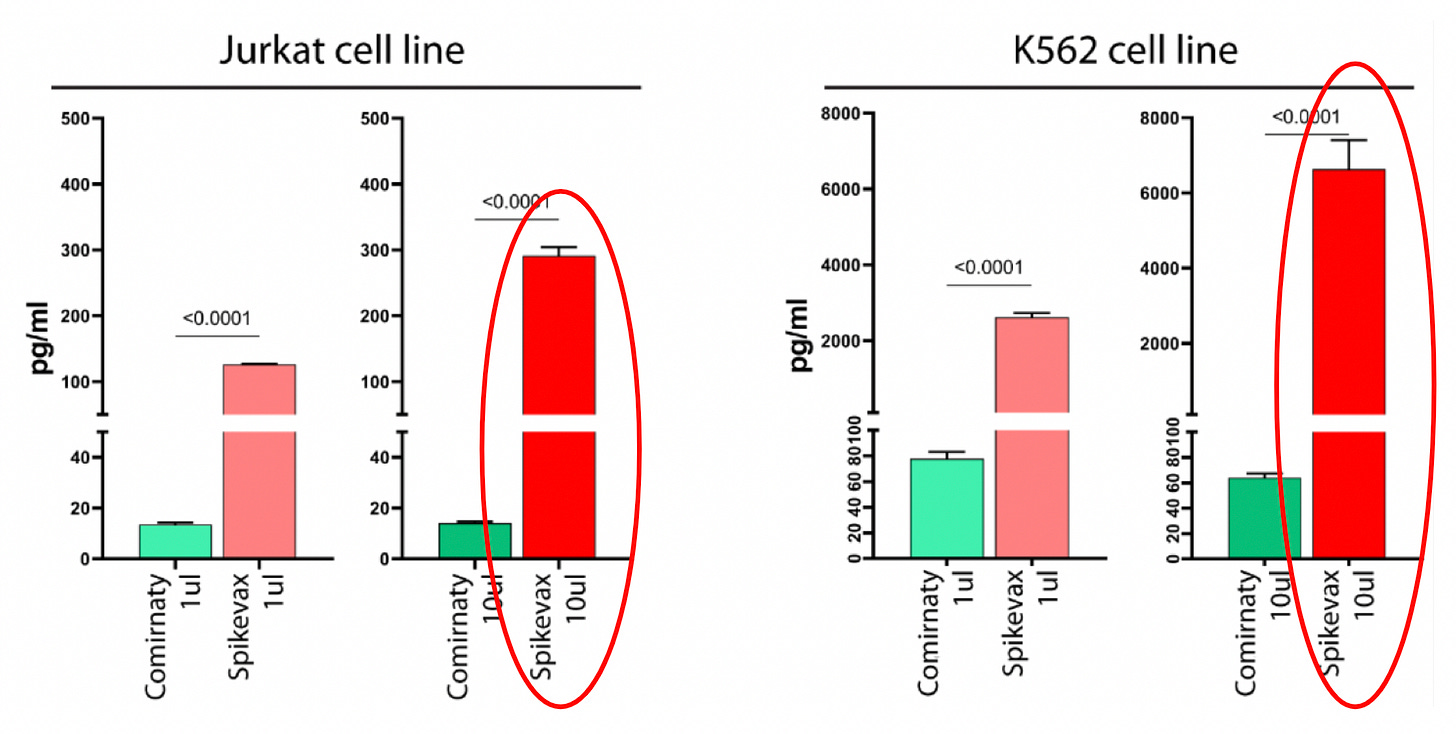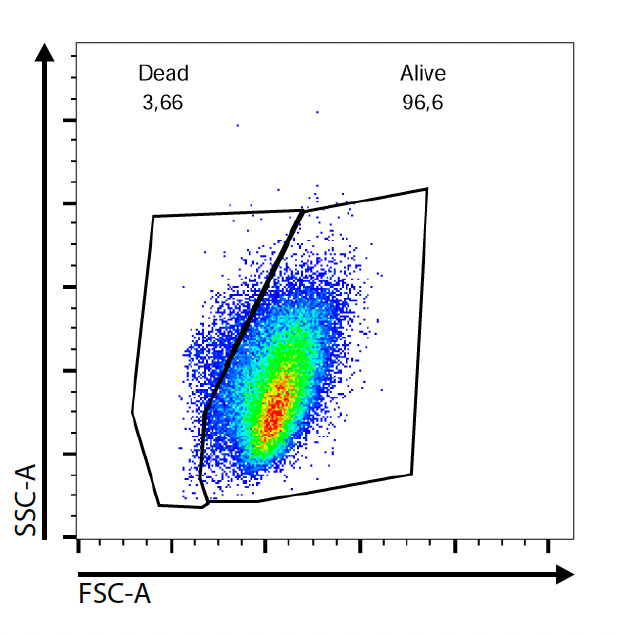New study shows how little we know about how mRNA vaccines "work"
Vastly different levels of spike protein depending on cell type
A recent study highlights just how clueless we are about how mRNA vaccines work:
We’ll go through some key findings of the study.
The amount of spike protein expressed on the cell surface depends on cell type
In the study, two different cell types (Jurkat or K562) were given either the Comirnaty (Pfizer) or Spikevax (Moderna) vaccines.
Both of these are mRNA vaccines that are supposed to encode for spike protein, and they’re supposed to work by getting cells to produce spike protein on the surface of the cells that take up the vaccine.
The graph below shows the percentage of cells that expressed spike protein on their surface after they were given either 1µL or 10µL dose of each vaccine:
The leftmost graphs shows results for Jurkat cells, whereas the rightmost shows results for K562 cells.
If we concentrate on just the cells that received 1µL of Spikevax (circled in red below), we can see that Jurkat cells had a much higher percentage of cells that expressed spike protein compared to the K562 cells (note the difference in scales):
We see the same thing if we focus on all the cells that received 10µL of Spikevax (circled in red below); Jurkat cells had a much higher percentage of cells that expressed spike protein compared to the K562 cells (again, note the difference in scales):
This is surprising; it’s unclear why Jurkat had higher spike expression compared to K562 cells.
Comirnaty showed less spike expression compared to Spikevax
We also see that cells that were given the Comirnaty vaccine showed a lot less spike expression compared to Spikevax. Below is the same graph, but with all the Comirnaty doses (green) circled:
This may not be that surprising given that Spikevax has a higher concentration of mRNA. In this study, 1 and 10 µL of both vaccines corresponded to 0.1 and 1 µg mRNA of the Comirnaty vaccine, and 0.2 and 2 µg mRNA of the Spikevax vaccine.
However, what is surprising is that in the Jurkat cells, there isn’t that much difference in spike expression between the cells that got 1µL and 10µL Comirnaty. Strange.
Loose spike shows a different pattern
Spike protein found on the surface of cells is not the only spike protein around. Some spike protein, or truncated (shortened) versions of it, gets loose from the surface of cells, and goes into the media that the cells are in.
In the graph below, the leftmost image shows loose spike associated with the Jurkat cells, while the rightmost graph shows the same but for K562 cells:
If we focus on the bars that received 10µL of Spikevax (circled in red); this time, we see more spike associated with the K562 cells compared to the Jurkat cells (notice the difference in scales). This is the opposite of what we saw with spike that was attached to the surface of cells.
For the Comirnaty vaccine, strangely, higher dose does not necessarily lead to more spike
Now if we focus on the cells that got Comirnaty (green) we’ll notice that just as with Spikevax, the K562 cells exhibited more loose spike protein compared to the Jurkat cells. In the graph below, all the cells that received Comirnaty are circled:
But what’s strange is that with Comirnaty, higher vaccine dose did not lead to higher spike protein expression. What’s going on?
Some cells die after they’re given the vaccine
Below shows the percentage of cells that were dead or alive after 24 hours with 10µL of Spikevax in the Jurkat cells:
It shows that around 3.66% of Jurkat cells died.
Below we see the percentage of cells that were dead or alive after 24 hours with 10µL of Spikevax, but this time, in the K562 cells:
It shows that around 11.4% of the K562 cells died.
So K562 cells seem to be more susceptible to vaccine toxicity compared to Jurkat cells.
It would have been interesting to see if more cells would have died had the researchers looked beyond 24 hours after the vaccine was given.
We saw hints of these results in previous studies
This isn’t the first time that we’ve seen hints of vaccine toxicity. For example, there are studies showing that the LNPs used to carry the mRNA vaccines, are highly inflammatory (see this and this). And spike protein itself seems to be harmful to cells (more here).
This is also not the first time we’ve seen spike protein expression differ in different cell lines. For example, take this study: Vaccine mRNA Can Be Detected in Blood at 15 Days Post-Vaccination
In that study, they gave the Comirnaty (Pfizer) vaccine to human bone marrow cells (K562 and HL-60) and isolated peripheral blood mononuclear cells and platelets (PBMCp).
All the cells seemed to take up the vaccine, but spike protein was absent on the surface of PBMCp or HL-60 cells. K562 cells had some spike expression, though only 3 out of 100 cells analysed had spike.
Recall that the current study also looked at K562 cells that were given Comirnaty, but showed a higher percentage of cells expressing spike. Why the difference? Perhaps it had to do with the vaccine dosage given, or the different methods for measuring spike.
We do not understand fundamental things about how mRNA vaccines “work”
The main point is this: we do not understand fundamental things about what happens after mRNA vaccines are injected into people.
For example, we saw that the Pfizer vaccine led to less spike protein expression, and yet there are studies that seem to show that the efficacy between Pfizer and Moderna are similar (example here). How could that be?
And what accounts for the differing levels of spike protein expression in the different cell lines?
Jurkat cells are T lymphocyte cells that were originally derived from a 14-year old boy with leukemia. K562 cells are bone marrow cells that were originally derived from a 53-year old female with leukemia.
Do the levels of spike expression differ between these cell lines because they are from two different people, or because they are different cell types, or both? What would happen with heart or brain cells? How much spike would they express if they accidentally took up vaccine LNPs?
And why is it that we see more surface spike in one cell line, but more loose spike in the other? Is it because one of the cell lines express more enzymes that cleave the spike off the surface of cells?
By the way, the researchers report that some of the loose spike was in the form of truncated (shorter) spike. Maybe that was spike that had been cleaved by enzymes, or maybe the mRNA itself was cleaved:
Alternatively, the assessment report of the Spikevax vaccine by the European Medicine Agency (EMA) reports that “the applicant described short mRNA species that can occur because of abortive transcription or premature termination of transcription. As the majority of these short mRNAs do not contain a Poly A tail, the manufacturing process includes chromatography steps, which aim at removing these impurities to a large extent.” However, “additional bands are observed by an in vitro translation assay” performed using the purified mRNA [6].
A similar problem was reported by Comirnaty’s manufacturer, but, in the case of Comirnaty, the chromatography steps are not performed [5]. Therefore, it can be hypothesized that some of the short mRNA species present in the LNP of Spikevax and Comirnaty are translated into truncated S-proteins that do not have the transmembrane domain and can exit from the cells, explaining the in vitro finding of the present study and the in vivo finding from other authors [14,24].
Translation: some of the mRNA might be shorter than what it’s supposed to be, which could lead to truncated versions of spike protein.
Even if the mRNA is the correct length, maybe the translation process sometimes aborts early because of all the changes made to the mRNA, like the codon optimization used, or the fact that N1-Methylpseudouridine was used to replace uridine in the mRNA. Perhaps this can lead to “mRNA” that sometimes gunks up the translation process in ribosomes.
As usual, the more we learn about these vaccines, the more questions arise.











Of course we know very little about it! These substances are bio-chemical poisons that have no legal requirement to be produced as described on the labels or advertised by manufacturers and government. Thus it is silly to ascribe any known mechanism of action to them. In addition, the shipped vials can contain, legally, any adulteration that the DOD wants to introduce, and can be shipped new or from prior decades of stock of the Strategic National Stockpile (used to be bioweapons stockpile by got renamed by Congress).
Thanks Joomi. If I hadn't lost my job for fighting against mandates, I would be a paid subscriber. When I win my case, I'll upgrade ✊